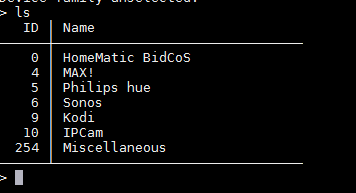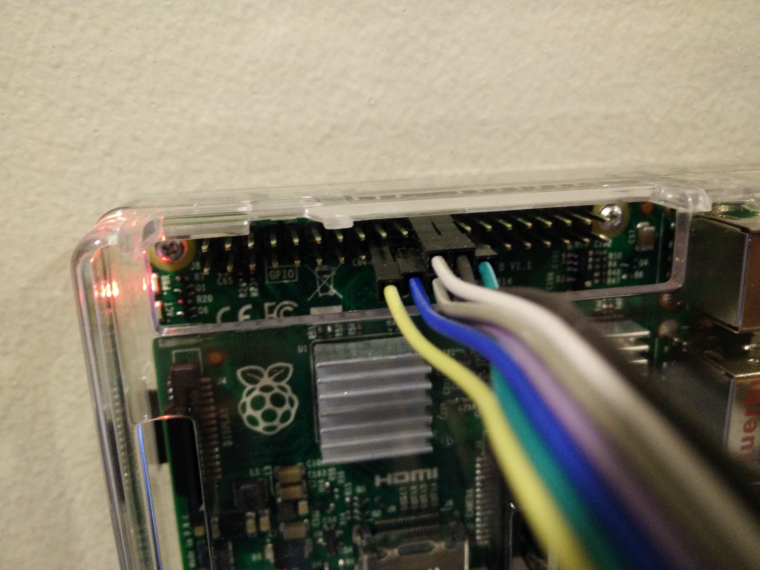Boiler control from MAX! Cube to Drayton Boiler via Raspberry Pi/Vera/Mysensors.
-
I believe I used this one: [https://forum.homegear.eu/t/CC1101-no-physical-device-found/921/2]
-
OK, so I've got my module, connected it to my Pi and installed homegear (used the Rasbian version with homegear and openhad installed). I connected to the Pi, ran homegear -r, families select 0, pairing on and started pairing on a device. However, I don't see anything in the peers list.
So, any ideas or obvious things I'm missing?
-
it should be families select 4 I believe, did you go into the max.conf and uncomment all the lines under ti cc1101 module? you may need to set gpio to 25 (not 23) and don't uncomment the the additional section. Reboot, then you should see 4 max! when "sudo homegear -r", "ls"

-
OK, so I uncommented the settings in max.conf (I hadn't got to those) and I do get the following

But no pairing when I do 'families select 4' then 'pon' and try to pair. The device just times out and an 'ls' doesn't show any devices.
I may try a cleaner install and start again. I've been following a few posts and translating them into English, but it's still not working. It could, of course, be my hardware.
Is there a log output somewhere that shows the hardware initializing?
-
Thanks. I'm using a different module, but the wiring looks the same. I'll try again later.
I didn't factory reset them. I'll try that.
-
It looks like I've got the wrong module. I ordered from ebay about 3 months ago and the title said "CC1101 315/433/868/915Mhz Wireless Module SMA Antenna Transceiver fr Arduino New", but the description talks about a default "433 mhz". I'm not sure if it's switchable, but it doesn't seem to work. I've ordered another for the grand price of £1.95, but it'll take a month or so to get here. :(
-
I've had a Honeywell wireless programmable thermostat for several years and the LCD is now a little temperamental so was looking for something new.
Found the Honeywell evoHome, then saw a link mention the MAX! products and then I found this thread which looks like what I'm after.
Its been 8 months since the last post on here so I was wondering what ever happened to this project? Its just seems to have stopped. Is it complete?
Did the CC1101 work so that the MAX! Cube is not required?
Did @Stuart-Middleton switch over to openhab2 and homegear?Just wondering do I use @stephenmhall code or go the openhab2/homegear route?
Thanks
Anthony -
Hey, @demusss. I'm still using the python script talking to the MAX! Cube. It's a little temperamental but works most of the time. I finally got my hardware (CC1101) but, if I remember right, the homegear instructions listed above don't seem to work anymore. There's a missing module? I can't recall now. I'm sure I could sort it out but I just haven't had time.
Ideally, I'd like to talk to the system myself via the CC1101 and write the software myself instead of relying on OpenHAB but time is the limiting factor, unfortunately.
Maybe I'll pick it up again this weekend and try and get the CC1101 comms working.
Stu
-
Wow Stu, quick reply.
What you've built is basically what I'm after, but from what I've read the Cube can be temperamental.
I do have RPi somewhere, so to have a play I may get a CC1101,
MAX! Wireless wall mount thermostat - BC-TC-C-WM-4 / 131651
MAX! TRV - BC-RT-TRX-CyN / 142016A0AI would like to control the system from my mobile so if I'm out late there's no point in the heating being on. There are some HomeMatic apps out there which work with openhab etc, but maybe using your web interface would be easier.
Anthony
-
Hey, Anthony.
Yeah, the cube is the temperamental bit. It forgets the sensors every few weeks/months.
I have opened up the python web page to the web, secured behind a password, and it's OK to use. I mainly use it to monitor the system and look at the pretty graphs. I think the CC1101 with OpenHAB or custom software is the way to go.
Let me know if you get the Pi and CC1101 installed. I can't recall exactly what was wrong but I think it may be one of the packages that it tries to download no longer exists. It's something I really want to get fully working the way I want it, but to be honest it does a good job anyway.
Stu
-
Hi Anthony.
Funnily enough I went from the MAX system to a Honeywell Evo system and Domoticz as I have elderly parents and could not risk the times the max just forgot about all its radiators and either left the heating off or on all day.
Had the Evo for maybe a year now with no problems. The only thing I miss with the evo is notification as to when the heating is actually on. And being able to work on my code as I did enjoy writing it.
If you need any help with the code just ask, although it has been a while since I looked at it :)
Stephen
-
Hey all,
I want to revive an old thread here. Ive been chatting to Stephen via github and plan to extend , perhaps take over?, development of his PiHeating package on github..
Ive created my own fork (based on twistedsanity as he added some nice docker defns) and I plan to make massive changes to it.. By trade Im a Java/Javascript developer and Im using this project as an excuse to learn/play with Python
- Please review my github issues Ive logged, Id love to know if people agree/disagree
- Are there many MAX! Users out there? if there are then I'll invest time in making the code read-able, and pluggable with HA controllers like HomeAssistant.. If there isnt much interest then I'll trim the code down to my needs (remove vera etc)
- Any other suggestions?? please log a Github issue and I'll look at it..
@twisted : are you twistedsanity on github?
My github repo is here https://github.com/asantaga/PiHeating
-
Hey all,
Well after long sessions of trial and error Ive given up on the Max! +Raspberry pi based on Stephens code. Regardless of how frequently you scan the max!cube it eventually looses its memory after 4-8 weeks.. Usually when Im not at home and thats not acceptable..
Shame as my setup with HomeAssistant was "perfect":-(
-
Hey all,
Well after long sessions of trial and error Ive given up on the Max! +Raspberry pi based on Stephens code. Regardless of how frequently you scan the max!cube it eventually looses its memory after 4-8 weeks.. Usually when Im not at home and thats not acceptable..
Shame as my setup with HomeAssistant was "perfect":-(
@angelos I was looking into the MAX setup initially but reports of the Cube falling over put me off completely, even where some appeared to have ZERO problems. Some seemed to have circumvented the problems by reflashing the Cube (hazy recollection) but cannot remember the details of who where what, as I discarded it when a plug-in card for the Pi3 was released by the parent company (ELV?).
I took it no further as I had set a target to cover all improvements from energy savings, so the budget didn't stretch to it having added insulation and improved Rad Valves, as well as the increased pricing on the market.
If any of that info is potentially any help, pm me and I'll dig out what I found.


